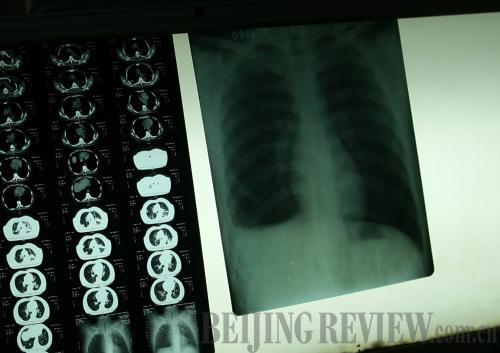|
 |
|
A SHADOW KILLER: A chest X-ray of a patient with tuberculosis (IC) |
He also called for inventing a much shorter or better treatment regimen, adding that the first year is crucial in the TB treatment process.
Wang Lixia, Director of the CDC's TB Prevention and Control Center, blames a lack of awareness for the growing problem of MDR-TB.
"Many TB sufferers know nothing about their condition, and are unaware today that their coughing and low fever signs are possibly symptoms of TB," Wang said.
More efforts needed
Coinciding with this year's World TB Day, a newly amended regulation went into effect to combat the insidious disease in China.
According to the new TB Prevention and Control Regulation, all newly enrolled students and people working in food, drugs and cosmetics industries should be screened for TB to prevent the spread of the highly contagious disease.
In November 2011, an outbreak was reported at east China's Zhejiang University, with 16 students affected. A month later, 40 students at Jiangsu University of Science and Technology, also based in east China, caught the disease.
The regulation also requires teachers, cattle farmers, medical staff involved in TB prevention and treatment and workers who come into contact with dust or poisonous gas to include screenings for the disease in physical check-ups.
Infectious TB patients must be prevented from engaging in activity that could cause the disease to spread, the regulation stipulates.
Thanks to various efforts, especially the TB Control Project, which initiated the free check and treatment policy in 2002, China's TB mortality rate saw an 80-percent drop from 1990 to 2010 and the prevalence rate was halved.
In the past 10 years, 8.29 million TB patients have been treated in China, according to official figures.
However, the country still faces many new challenges in its TB prevention, according to Chen Mingting, Deputy Director of the CDC's TB Prevention and Control Center.
According to statistics from health authorities, more than 80 percent of China's TB patients are from rural areas. "Among them migrant workers are the most vulnerable because once they get sick, most cannot get systematic treatment," Chen said.
Chen attributes the high TB prevalence among migrant workers to their irregular lifestyles, nutritional deficiency, intense pressure from work, as well as high-density living conditions.
Despite favorable policies made for non-resident population, including free medical tests and treatments, curbing TB in cities is still a big challenge, said Zhang Lixing, President of the Chinese Anti-Tuberculosis Association.
Due to the fear of being fired by bosses or quarantined from other people, many TB sufferers delay treatment.
"Early detection and treatment of TB patients is crucial. And if a case can be diagnosed in the early stages, the possibility is high that a patient makes a complete recovery," Zhang said.
The new TB Prevention and Control Regulation stipulates that medical and health institutions should make localized administration to "migratory" TB patients, providing them with the same treatment services as those local residents. The designated TB hospitals in cities and their hometowns should exchange the patients' information in time to guarantee appropriate treatment and management.
It also requires health authorities to protect patients' privacy and refrain from leaking their personal information and related materials. Medical or disease prevention and control facilities that conceal, delay disclosure of or fabricate information regarding TB epidemics or intentionally leak the private information of TB patients, suspected patients and close contacts will receive a warning. Those found responsible will be disciplined or prosecuted, the regulation states.
Meanwhile, the government has pledged to put more effort into to conquer MDR-TB, especially in rural areas.
According to the National TB Control Plan (2011-15), China will increase MDR-TB diagnosis and treatment coverage to 50 percent by 2015.
To achieve the target, the government must invest more in public health services to better diagnose drug-resistant strains, establish a mechanism to coordinate prevention and treatment, and extensively mobilize social organizations to participate in the fight to reduce the emergence of new cases, said Wang Yu.
Email us at: yinpumin@bjreview.com | 